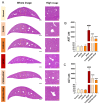Curcuma aromatica Salisb. Protects from Acetaminophen-Induced Hepatotoxicity by Regulating the Sirt1/HO-1 Signaling Pathway
- PMID: 36839166
- PMCID: PMC9964786
- DOI: 10.3390/nu15040808
Curcuma aromatica Salisb. Protects from Acetaminophen-Induced Hepatotoxicity by Regulating the Sirt1/HO-1 Signaling Pathway
Abstract
Acetaminophen (APAP) overdose-induced hepatotoxicity reduces the activity of sirtuin-1 (Sirt1) along with heme oxygenase 1 (HO-1) and promotes inflammatory responses and oxidative stress. Although the extract of Curcuma aromatica Salisb. (CAS) possesses hepatoprotective properties, scientific evidence on whether CAS prevents hepatotoxicity and the underlying molecular mechanisms are lacking. Here, we hypothesized that CAS ameliorates hepatotoxicity by inhibiting inflammation and oxidative stress via Sirt1/HO-1 signaling. CAS pretreatment at doses of 200 and 400 μg/mL significantly increased cell viability in APAP-treated primary hepatocytes. The expression of inducible nitric oxide synthase (iNOS) substantially increased after APAP treatment; however, this expression significantly decreased in cells pretreated with 100, 200, and 400 µg/mL CAS. CAS increased Sirt1 and HO-1 levels in APAP-treated hepatocytes in a dose-dependent manner. When CAS was orally administered to mice at doses of 20 or 100 mg/kg for 7 days, the APAP-induced increase in serum aspartate aminotransferase and alanine aminotransferase levels was inhibited. Moreover, CAS decreased IL-6, TNF-α, and IL-1β, increased IL-10, suppressed ROS generation, increased glutathione levels, inhibited iNOS and cyclooxygenase-2, and enhanced Sirt1 and HO-1 in the mouse model of APAP-induced hepatotoxicity. These findings suggest that CAS could be used as a natural hepatoprotective drug to treat APAP-induced injury.
Keywords: Curcuma aromatica Salisb.; HO-1; Sirt1; acetaminophen; hepatotoxicity; paracetamol.
Conflict of interest statement
The authors declare no conflict of interest.
Figures





Similar articles
-
Limonin ameliorates acetaminophen-induced hepatotoxicity by activating Nrf2 antioxidative pathway and inhibiting NF-κB inflammatory response via upregulating Sirt1.Phytomedicine. 2020 Apr;69:153211. doi: 10.1016/j.phymed.2020.153211. Epub 2020 Mar 20. Phytomedicine. 2020. PMID: 32259676
-
Seabuckthorn berry polysaccharide extracts protect against acetaminophen induced hepatotoxicity in mice via activating the Nrf-2/HO-1-SOD-2 signaling pathway.Phytomedicine. 2018 Jan 1;38:90-97. doi: 10.1016/j.phymed.2017.11.007. Epub 2017 Nov 14. Phytomedicine. 2018. PMID: 29425659
-
Dandelion polyphenols protect against acetaminophen-induced hepatotoxicity in mice via activation of the Nrf-2/HO-1 pathway and inhibition of the JNK signaling pathway.Chin J Nat Med. 2020 Feb;18(2):103-113. doi: 10.1016/S1875-5364(20)30011-X. Chin J Nat Med. 2020. PMID: 32172946
-
Carbon monoxide ameliorates acetaminophen-induced liver injury by increasing hepatic HO-1 and Parkin expression.FASEB J. 2019 Dec;33(12):13905-13919. doi: 10.1096/fj.201901258RR. Epub 2019 Oct 23. FASEB J. 2019. PMID: 31645120
-
Protective Effects of Tormentic Acid, a Major Component of Suspension Cultures of Eriobotrya japonica Cells, on Acetaminophen-Induced Hepatotoxicity in Mice.Molecules. 2017 May 18;22(5):830. doi: 10.3390/molecules22050830. Molecules. 2017. PMID: 28524081 Free PMC article.
Cited by
-
The role of sirtuin1 in liver injury: molecular mechanisms and novel therapeutic target.PeerJ. 2024 Mar 29;12:e17094. doi: 10.7717/peerj.17094. eCollection 2024. PeerJ. 2024. PMID: 38563003 Free PMC article. Review.
-
Curcumin's Protective Role in Heatstroke-Induced Acute Liver Injury: Targeting Pyroptosis and Enhancing SIRT1 Expression.Glob Chall. 2024 Oct 13;8(12):2400178. doi: 10.1002/gch2.202400178. eCollection 2024 Dec. Glob Chall. 2024. PMID: 39679288 Free PMC article.
-
Exploration of the Molecular Mechanism of Curcuma aromatica Salisb's Anticolorectal Cancer Activity via the Integrative Approach of Network Pharmacology and Experimental Validation.ACS Omega. 2024 May 1;9(19):21426-21439. doi: 10.1021/acsomega.4c01759. eCollection 2024 May 14. ACS Omega. 2024. PMID: 38764617 Free PMC article.
-
Twelve Shugan Lidan Granules from traditional Chinese medicine can improve liver function in patients with postoperative hepatolithiasis by inhibiting the Hippo signaling pathway.Am J Transl Res. 2024 Nov 25;16(11):7186-7199. doi: 10.62347/VXHU6738. eCollection 2024. Am J Transl Res. 2024. PMID: 39678602 Free PMC article.
-
Natural Products for Acetaminophen-Induced Acute Liver Injury: A Review.Molecules. 2023 Dec 1;28(23):7901. doi: 10.3390/molecules28237901. Molecules. 2023. PMID: 38067630 Free PMC article. Review.
References
-
- Larson A.M., Polson J., Fontana R.J., Davern T.J., Lalani E., Hynan L.S., Reisch J.S., Schiodt F.V., Ostapowicz G., Shakil A.O., et al. Acetaminophen-induced acute liver failure: Results of a United States multicenter, prospective study. Hepatology. 2005;42:1364–1372. doi: 10.1002/hep.20948. - DOI - PubMed
-
- Reddy K.R., Ellerbe C., Schilsky M., Stravitz R.T., Fontana R.J., Durkalski V., Lee W.M., Acute Liver Failure Study Group Determinants of outcome among patients with acute liver failure listed for liver transplantation in the United States. Liver Transpl. 2016;22:505–515. doi: 10.1002/lt.24347. - DOI - PMC - PubMed
MeSH terms
Substances
Grants and funding
LinkOut - more resources
Full Text Sources
Medical
Research Materials

